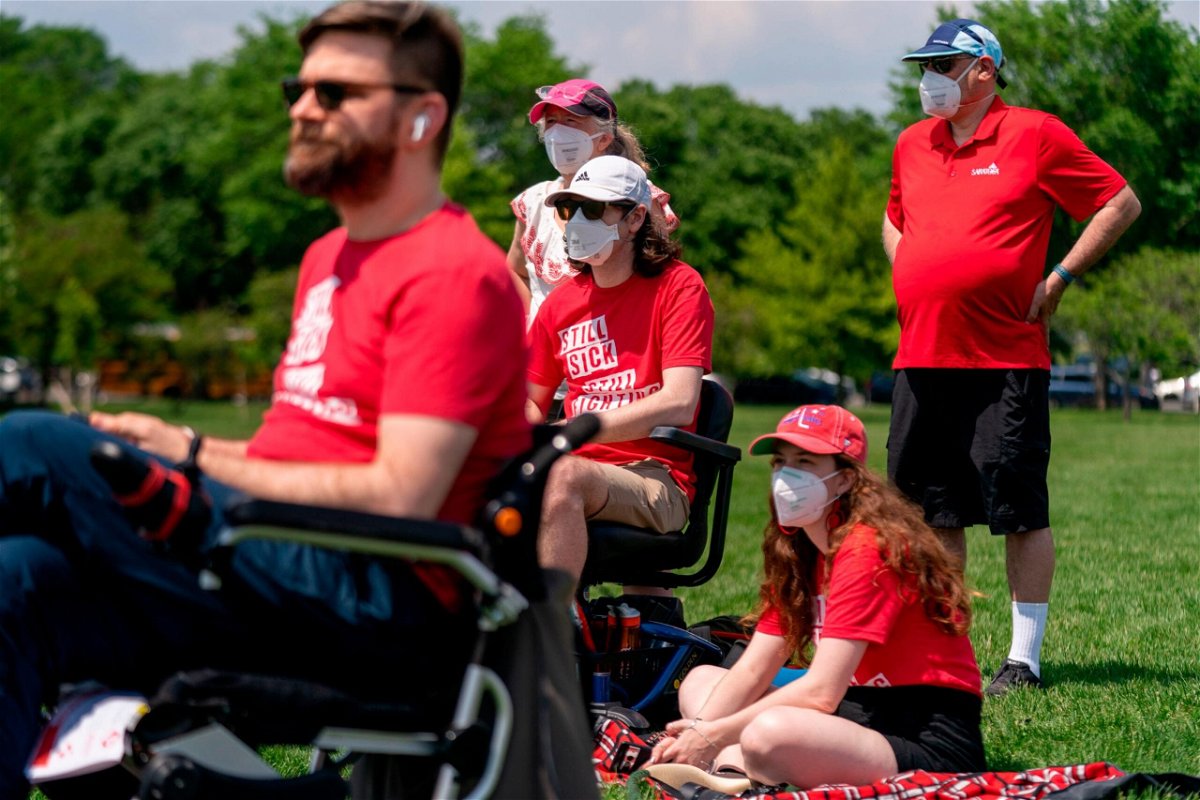12 key symptoms define long Covid, new study shows, bringing treatments closer

Advocates for people suffering from long COVID-19 and chronic fatigue syndrome install 300 cots in front of the Washington Monument in Washington
By Brenda Goodman, CNN
(CNN) — After more than two years and an investment of nearly $1.2 billion, researchers say they’ve come up with a list of 12 symptoms that can reliably classify someone as having long Covid, a working definition that should accelerate research into the disabling condition.
The study, which was published Thursday in the medical journal JAMA, is the first research to emerge from a large effort following more than 13,000 adults at more than 200 study sites as part of the National Institutes of Health’s RECOVER initiative, which stands for Researching Covid to Enhance Recovery.
The cohort, one of five arms of RECOVER, was launched in September 2021, with an award of nearly half a billion dollars – a sizeable chunk of the entire RECOVER budget – going to New York University’s Grossman School of Medicine.
With its massive budget and scope, the RECOVER initiative has been a great hope of people with long Covid, some of whom are too ill to leave a bed or a chair for long.
Census data suggests that 15% of US adults experienced new or lasting symptoms months after their initial infections, a phenomenon scientists have dubbed postacute sequelae of SARS-CoV-2 infection, or PASC. More than 200 symptoms have been reported by people with PASC or long Covid.
Many of these patients have been disheartened by what they see as a lack of urgency on the federal government’s part as deadlines for starting clinical trials to test potential treatments have slipped. Instead, they say, the focus has been on observational studies like this one, which are attempting to characterize a problem that they feel has already been well-defined – by decades of research on post-viral illnesses.
Still, NIH organizers have defended their decision to invest in this definition, which they say is essential to finding effective treatments.
The adult cohort “is going to be the largest, most diverse cohort of long Covid patients that are deeply characterized in the world,” said Dr. Gary Gibbons, director of the National Heart, Lung, and Blood Institute.
Doctors who treat people with long Covid but who were not involved in the study said they were pleased to see the new criteria.
“I know that we’re all impatient to get answers. We’re all impatient to have evidence-based therapeutic recommendations,” said Dr. Daniel Griffin, an infectious disease specialist at Columbia University.
“But we understand the challenge here. … This is a new disease. This is a new phenomenon. And before we rush in and waste a lot of resources with bad trials, we need to understand what we’re studying. We need to understand the target group,” Griffin said.
The search for long Covid treatments has been stymied by the lack of a biomarker, something that doctors can test for or measure that will tell them if a person has the disorder.
In diseases like lupus, in which a unique biomarker hasn’t been found, doctors often rely on clinical scales to make a diagnosis.
“We have lots of diseases for which we don’t have like a single blood test. And in those cases, we have a set of symptoms. And we look for people who meet that set of symptoms,” said Dr. Leora Horwitz, a professor in the Departments of Population Health and Medicine at NYU and one of the new study’s lead investigators.
The World Health Organization and the US Centers for Disease Control and Prevention define long Covid as any signs, symptoms or conditions that continue or develop after a Covid-19 infection.
Although that definition allows for people with a wide range of symptoms to be considered for treatment, it’s not very useful for research, Horwitz said.
“We need something concrete being defined and say ‘this is a group of people who we think have this condition,’ and we can then study them and understand what is going on in their bodies,” she said.
For the study, researchers asked nearly 10,000 adults – some who were previously infected and others who had never had Covid, based on antibody testing – to answer a detailed set of questions about 44 symptoms affecting all parts of the body. Symptoms that appeared in more than 2.5% of individuals were then considered, narrowing the list to 37.
From there, they gave each symptom a score. Twelve symptoms got a score of 1 or higher:
• Postexertional malaise, or the worsening of health after mental or physical activity
• Fatigue
• Brain fog
• Dizziness
• Gastrointestinal symptoms
• Heart palpitations
• Changes in sexual desire or capacity
• Loss of or change in smell or taste
• Thirst
• Chronic cough
• Chest pain
• Abnormal movements
The symptoms are weighted according to how likely they are to appear in people who have long Covid compared with those who don’t. Loss of smell or taste was given 8 points, for example, because it is really unusual in people who haven’t had Covid. Dizziness gets a score of 1.
People who scored a 12 or higher based on all their symptoms were defined as having long Covid.
“It’s trying to pick out those symptoms that are really just most distinguishing,” Horwitz said. “That doesn’t mean that they are the most common, that they’re the most severe, that they’re the most burdensome, that they’re the most important to patients. It doesn’t mean any of that. It just means these are the ones that collectively are just much more likely to be found in in people who have had Covid than who haven’t.”
When researchers applied the criteria to the entire group of people they’re following for the study, they found that it flagged about 23% of those who were previously infected and just 4% of those who had never been infected, making it unlikely that someone who scored 12 points on the scale would be a false positive – meaning they screened as positive, but didn’t actually have it.
They were able to learn some things about their study participants, too. For example, people were more likely to have long Covid if they were infected before the arrival of the Omicron variant: About 35% of people infected pre-Omicron met the definition of Long Covid, versus about 10% of study participants who were infected with Omicron’s subvariants.
Researchers said that doesn’t mean that more than 1 in 3 people who caught Covid before Omicron arrived ended up with long Covid, however. Instead, they think people in the study who were infected before November 2021, likely signed up because they were still struggling with health issues and motivated to get answers, and so they think their study population may be enriched with more severe cases from the pre-Omicron era.
Among participants who were first infected during Omicron, long Covid was more likely to happen after a subsequent reinfection, a finding that validated earlier studies based on health records.
People were more likely to have long Covid if they were hospitalized with their infection and less likely to develop it if they were vaccinated.
Horwitz says the findings underscore the critical importance of staying up to date on vaccination.
“This is something that anybody can do, to be vaccinated and to be boosted as the boosters come out. And it is, I think, one of the few things that people can proactively do to reduce their risk” of long Covid, she said.
The researchers also learned that long Covid seems to be distinct from a condition called myalgic encephalitis/chronic fatigue syndrome or ME/CFS, which can also follow a viral illness.
Horwitz said that although most people in the study who met the definition of ME/CFS also met the definition of long Covid, the converse wasn’t necessarily true. Among people who met the definition of long Covid, only about 10% to 20% would have also met the definition of ME/CFS, meaning it may be an important subset of patients but isn’t exactly the same.
The researchers said certain symptoms seemed to cluster together and define subgroups of long Covid patients. People with loss of smell or taste didn’t seem to have many other symptoms, indicating a milder course. A second group reported mainly postexertional malaise, fatigue and gastrointestinal trouble but no trouble with thinking or memory. A third subset reported mostly postexertional malaise, fatigue and brain fog. A fourth group – the most severely affected – had multiple symptoms and most commonly reported fatigue, postexertional malaise, heart palpitations, dizziness, brain fog and weakness.
That may end up being a limitation of the scale and one of the reasons it needs to continue to be refined, said Drs. Robert Gross and Vincent Lo Re III, of the University of Pennsylvania’s Perlman School of Medicine, who co-wrote an editorial published alongside the study.
“It may not be appropriate for an individual debilitated by fatigue and brain fog and an-
other individual who is highly functioning despite loss of taste and smell to similarly be labeled as having the same single entity,” they wrote.
The study has other important limitations, too. It hasn’t reached full enrollment, and the information may change as more people are considered in the analysis.
People are also able to sign themselves up to participate, so it may be more weighted to those are motivated to join because of continuing health problems.
While the race and ethnicity of study participants is reflective of the larger US population – about 15% were Black, and 16% were Hispanic or Latino — it has an imbalance in terms of sex. Nearly three-quarters of participants are female. And only about 5% of participants come from rural areas. So it may not represent the experiences of men or of people in rural areas.
It also doesn’t apply to kids, who will be getting their own long Covid scale.
The study authors say that while a symptom scale like this one may be used to diagnose people with long Covid down the road, this one shouldn’t be, because it’s just a first attempt and needs to be refined.
Daniel Lewis, a long Covid patient and advocate, agrees that the definition needs more work and worries that doctors might rush to bring it into clinical care.
“I really want no one to ever use this for a clinical diagnosis,” said Lewis, who spends most of his day in a bed or electric wheelchair after a Covid infection 10 months ago.
He feels that this first version of the definition would leave too many people out.
“Doctors are reading this, and they’re trying to figure out if their patients have long Covid. I don’t think this is a good way to do it,” he said.
The-CNN-Wire
™ & © 2023 Cable News Network, Inc., a Warner Bros. Discovery Company. All rights reserved.



